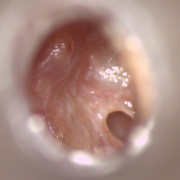You are here
Cholesteatoma and Middle Ear Granulation Disease
Testimonial from Ooi Hua Beng treated for cholesteatoma (chronic middle ear disease)
If the skin lining the ear drum enters the middle ear, it continues to grow like a snow ball and destroy everything in its path. This is called a cholesteatoma. It can damage the middle ear bones producing conductive deafness. It can go deeper and erode the bony barrier between the middle ear and the brain causing a brain abscess (infection), erode the bony barrier between the middle ear and the inner ear causing sensorineural deafness or dizziness, or even cause weakness of the face due to damage to the facial nerve. A less aggressive form of middle ear disease is Granulation disease. This is due to inflamed (usually) infected swollen lining of the middle ear causing a similar but slower and less aggressive erosion of these vital structures in the middle ear. Surgery is the main treatment and traditionally involves removing part of the ear canal and the middle ear bones to clear the disease, resulting in a cavity that needs regular cleaning and conductive deafness respectively. Using advanced drilling techniques and a laser the disease can be often cleared without these side effects of traditional surgery, hence producing better form and function. See Laser Cholesteatoma.
Otosclerosis and Stapes Surgery

Testimonial from Lesley Haggett who underwent Left KTP Laser-Asssited Revision Stapes Surgery
If the 3rd middle ear bone called the Stapes (also known as the Stirrup the smallest bone in the human body) becomes fused to the inner ear it cannot vibrate properly and there is conductive deafness This is usually due to a condition called Otosclerosis. Stapes surgery can restore hearing by removing the fused Stapes bone and inserting a mobile piston in its place (as above) to restore sound conduction from the ear drum to the inner ear. Using a laser allows less transmitted movements to the inner ear during the procedure, and thus helps avoid inner ear injury to deliver an even better outcome. See Laser Stapes.
Ear Drum Perforation
The middle ear is usually sterile or nearly sterile unlike the ear canal which contains bacteria. Because of a perforation / hole in the ear drum (seen above) these organisms can enter the middle ear. Ear drum surgery seals off the middle ear and reduces ear discharge. See Ear Drum Surgery.
Narrow Ear Canal
Some patients have a narrow ear canal. This can provide an insufficient view of the ear canal, ear drum or deeper structures. Hence sometimes the canal needs to be widened. See Meatoplasty / Canalplasty.

